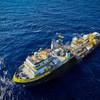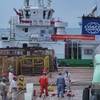Feature: Training for Life at Sea
By Larry Pearson
Training is literally the lifeblood of a boat owner's company. That is especially true of that company is Edison Chouest Offshore (ECO) owner and operator of over 100 vessels in the Gulf of Mexico. All of the vessels are crewed by Chouest employees, so employee training has become more important, not just to meet applicable Coast Guard licensing regulations, but to operate extremely complex vessels in a safe and efficient manner
The Galliano, La based company first established a training center in early 1999 using space in the company's main office building. By the end of 1999 the training center was in its own two-story building adjacent to the main office building.
"Our training center operates year around offering a wide variety of courses, typically lasting five days a week from 8:00am to 5:00pm," said Warren Sanamo, Jr. director of the training center. The courses are free for all Chouest employees and include a daily complimentary lunch for all participants.
"The STWC95 convention regulations determine the mandatory minimum standards of competence for seafarers performing duties on vessels of 200 gross tons or more operating in domestic waters and all vessels operating in international waters," said Chad Hebert, manager of safety and training for ECO. "One of our tasks is to be sure all of our mariners have the skills to get the STWC95 Certificate of Endorsement issued by the Coast Guard.
"In fact, most all of the vessel positions on Chouest boats require this Certificate of Endorsement including Q-Meds and Ordinary Seamen/Wipers/Oilers if they stand a watch.
Courses offered at the Chouest Training Facility goes well beyond the STWC95 certificate and include basic and advanced dynamic positioning training, bridge resource management and other courses.
The ECO Training Center is well equipped and includes:
• Four classrooms with overhead projectors and computers
• One classroom with eight Kongsberg student Dynamic Positioning simulators
• One classroom with six GMDSS/Radar/ARPA student simulator stations
• One computer self study classroom with four student stations
• Environmental Pool with life raft, life floats, helicopter underwater egress training simulator, training simulator, survival gear and a platform for elevated water entry
• Training Field-An area capable of conducting both basic and advanced fire training utilizing a variety of fuels (natural gas, tekflame, hay) and extinguishing agents (water, CO2, dry chemical, foam).
• Twelve offices for instructors and staff
• A covered pavilion equipped with mist cooling system that is used for outside training classes.
"Our Basic Safety Training course is a 40-hour, five-day course that is offered one or twice a month," added Hebert. This course includes 12 hours covering the use of life saving equipment and survival craft. Much of this training is done in the Training Center's Environmental Pool includes donning a life jacket, jumping from height into the water, swimming with a life jacket righting an inverted life raft, boarding survival craft and initiating actions to enhance survival.
The next part of this basic course is a 16-hour segment covering basic fire fighting utilizing the outdoor marine vessel simulation structure consisting of an engine room, cabin and a galley as well as various props to simulate an actual fire emergency.
There is also a four-hour course called Personal Safety that covers safe work practices, contingency plans, muster stations and personal safety and personal safety and equipment.
Rounding out this 40-hour course is an eight-hour session on Basic First Aid/CPR where the student must demonstrate through understanding and proficiency the immediate measures that must be taken in cases of emergency including the ability to apply resuscitation techniques, control of bleeding, managing casualties including rescue and transport.
A four-day course "Proficiency in Survival Craft" is taught at least once a month at the Training Center. This course teaches students to take charge of a survival craft and use supplies as effectively as possible. Traditional classroom teaching is used plus hands-on training consisting of a davit launched rescue boat and a totally enclosed motor propelled survival craft.
Another course offered by the Training Center is a 70 hour, 10-day course on the Global Maritime Distress and Safety System (GMDSS). This course is designed to give students the knowledge and ability to operate GMDSS equipment and understand the basic principals of emergency communications. As noted above, the classroom used for this training has a classroom equipped with six GMDSS simulator stations and a station for the instructor.
The Training Center offers three radar courses.
A one-day Radar Renewal course is designed to refresh the student knowledge of the rules of restricted visibility and safe speed and to test their ability to plot targets using radar simulations. A more comprehensive course of radar principles and the ability to plot targets is a weeklong 40-hour endeavor. Finally the Training Center offers Automatic Radar Plotting Aids, a 4.5-day course using in-house classroom simulators helping the student to interpret and analyze information obtained from automatic radar plotting aids.
ECO now has some form of dynamic positioning on 70 of its vessels. "Understanding DP equipment and how it functions is a major program here at the Training Center," said Hebert.
ECO offers both a 40-hour basic DP course and a 40-hour advanced course. The basic course emphasizes safety aspects and practices of DP operations as well as familiarization with the different components of DP systems.
The advanced DP course looks at DP systems in greater depth giving the students hands-on practical assessments.
Advanced firefighting is another must course for Captains, mates and engineers. Classroom training plus hands-on simulations in the Burn Building make this course very realistic as to the conditions mariners may face during a fire at sea.
Rating Form Part of an Engineering Watch is another course taught monthly at the Training Center.
It is a weeklong course that is a part of the requirements for SRCW95 Table A-lll/4 and Section B-lll/4 covering all of the duties and responsibilities for engine room watch keeping procedures.
ECOs dedication to safety extends to employees on land. Decision Driving is a Liberty Mutual Insurance course and is required for all employees driving company owned or leased vehicles.
As a company benefit, any employee can avail himself or herself of a four-hour course in child/infant CPR, at no cost.
"All of our trainers are licensed in a particular area, either on deck or in the engineering spaces," Hebert said.
"We are not immune from training either," Sanamo added. "We are involved in a 40-hour Train the Trainer course as well.













